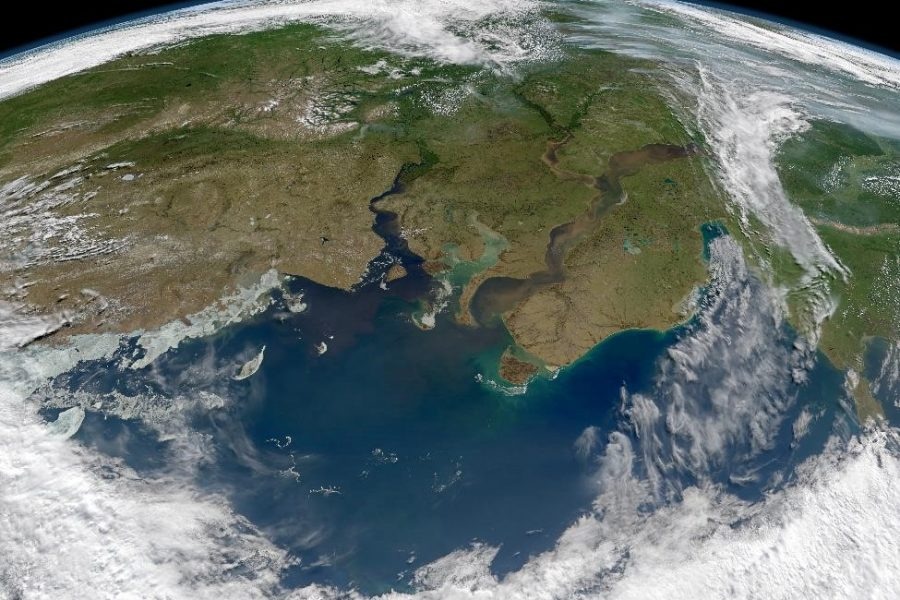Aug 29 2018
During the last several decades, the Arctic has started to display signs of substantial ecological upheaval. The rate of warming in the Arctic is virtually twice the world average, and those changes are activating a torrent of destabilizing environmental effects. Ice is melting, permafrost is thawing, and specialists say fires in Arctic forests are as destructive as they have been in 10,000 years.
 In two major Arctic rivers, a changing climate and shifting human activities are provoking a surprising response. (Image credit: Norman Kuring, NASA)
In two major Arctic rivers, a changing climate and shifting human activities are provoking a surprising response. (Image credit: Norman Kuring, NASA)
But a new study proposes that the same factors triggering the Arctic’s changing climate are stimulating a geological response that could play a minor part in counteracting those changes’ malign effects.
In a research reported in the journal Environmental Science & Technology, scientists from Florida State University state that, in two major Arctic rivers, 40 years of climate change seem to have triggered a natural process that consumes and stores atmospheric carbon dioxide (CO2).
The process of interest to scientists was the creation of riverine alkalinity, or the ability of river water to resist variations that would make it more acidic. Alkalinity is created when CO2 dissolved in rainwater weathers rock surfaces. As the rocks weather, the carbon atom contained in CO2 is changed from an atmospheric gas into a salt that can be geologically stored for millennia.
Generally, the more alkalinity identified in a particular waterway, the more CO2 was absorbed from the atmosphere.
“The production of alkalinity is a natural way that the Earth recycles atmospheric carbon dioxide,” said research lead author Travis Drake, a doctoral candidate in FSU’s Department of Earth, Ocean and Atmospheric Science.
The formation of alkalinity creates a CO2 “sink,” a system that functions in opposition to natural and anthropogenic CO2 emission. The scientists aimed to establish how changing human activity and the radical shifts in Arctic climate might be impacting alkalinity production in two of the region’s largest rivers, the Ob’ and the Yenisei.
There were direct methods of sampling alkalinity in the modern rivers, but for historical measurements, the team depended on reams of decades-old biomonitoring data.
Since there are many changes underway in the Arctic as a result of climate change and other anthropogenic activity, we hypothesized that the production of alkalinity may have also changed over time. Through collaboration with our Russian colleagues, we were able to recover a historic alkalinity dataset dating back to the Soviet era.
Travis Drake, Lead Author
After parsing the data and comparing historical alkalinity rates with current measurements, the scientists’ suspicions were validated. Alkalinity increased for both the Yenisei and Ob’ rivers, as well as the rates had risen steeply to an incredible 185 and 134%, respectively over the 40-year interval—two figures that dwarf the rates of increase in equally large rivers like the Mississippi (59% spanning the past 47 years).
Probable causes for the substantial alkalinity increases are diverse. Thawing permafrost, exposure of unweathered mineral surfaces, increased water flows, variations in acid deposition from human industry, and CO2 fertilization of Arctic plant life are all possible pieces of this unforeseen puzzle.
But the upshot is basic: In these rivers that shape thousands of miles through the severe Arctic landscape, human activity appears to be stimulating a pronounced reaction.
“If climate change is causing an increase in alkalinity production in the Arctic, it could be acting as slight negative feedback to warming, which is a good thing,” Drake said.
While increasing alkalinity won’t approach the magnitude of response needed to counterbalance anthropogenic CO2 emissions, scientists said these findings demonstrate the dynamic way Earth systems react to severe climate shifts.
We still very much have to worry about the alarming rate at which CO2 is increasing in our atmosphere, but this highlights the complexity and somewhat homeostatic dynamics of the global carbon cycle.
Travis Drake, Lead Author
FSU Associate Professor of Oceanography Robert Spencer contributed to this research, together with Suzanne Tank from the University of Alberta, Alexander Zhulidov and Tatiana Gurtovaya from the South Russia Centre for Preparation and Implementation of International Projects and Robert Holmes from the Woods Hole Research Center. The study was supported by the National Science Foundation.